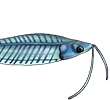https://doi.org/10.1155/2023/5158180
https://www.hindawi.com/journals/jai/2023/5158180/
Abstract
is a Loricariid endemic to a very limited stretch of the Xingu River and has a high value in the ornamental fish trade. The natural populations have experienced high fishing pressure since the late 80s and were recently impacted by the construction of the third largest hydroelectric dam complex in the world, the Belo Monte Project. Since 2004, it has been considered critically endangered and had its capture and trade forbidden. Even with its capture and trade prohibited since 2004, the species continues to be one of the most trafficked fish in the world. The biometric knowledge of the species is essential for monitoring its natural populations and management in ex situ environments. This work aims to establish the weight-length relationship (WLR) and length-length relationship (LLR) of the species and to evaluate the condition factor (K) of H. zebra rescued from trafficking. The study was conducted at the Laboratório de Aquicultura de Peixes Ornamentais do Xingu from February 2022 to June 2022, estimating the parameters of WLR and LLR of 1165 specimens divided into four simple linear regression (SLR) models: all specimens, only juveniles, only females, and only males. The K of 190 specimens rescued from trafficking by the Brazilian Federal Police was evaluated. The WLRs and LLRs were estimated using SLR. The difference between the allometry coefficients (b) and between the residuals of the models (juveniles, females, and males) was evaluated using the ANOVA significance test. The total length of the species ranged from 1.6 to 9.3 cm. The coefficient of allometry (b) of the WLR of the species is 3.22 and of the LLR is 1.04, demonstrating that H. zebra presents positive allometric growth. The evaluation of the residuals of the models showed differences between ontogenetic stages and between sexes. The development of juveniles is isometric until the first sexual maturation phase and differs in negative allometric for females and positive allometric for males, showing sexual dimorphism in the species. Among the specimens rescued from trafficking, 54.74% were underweight, and 13.16% were under 60% of the expected K value, demonstrating the poor conditions in which these animals are transported by trafficking.





